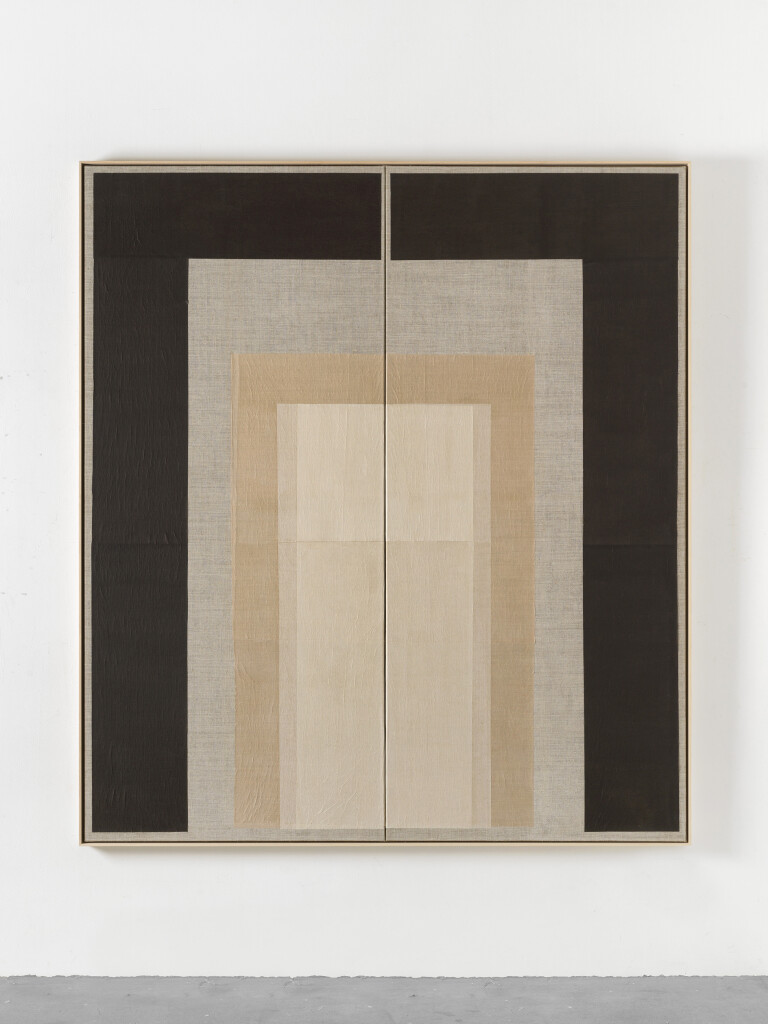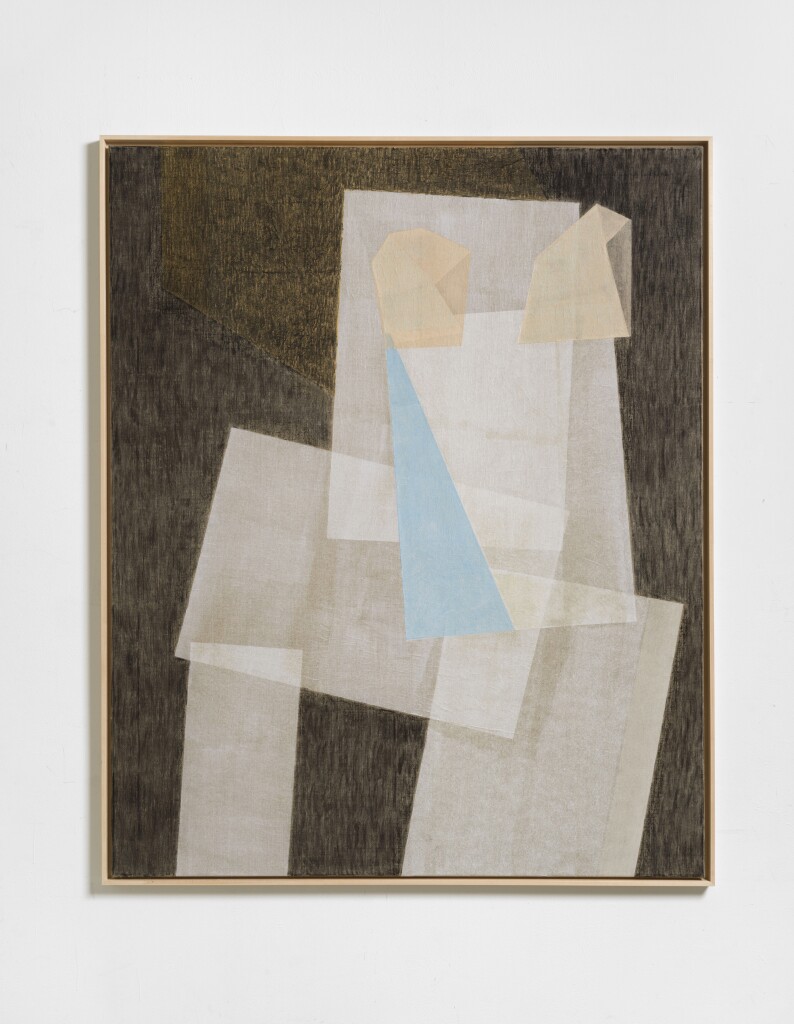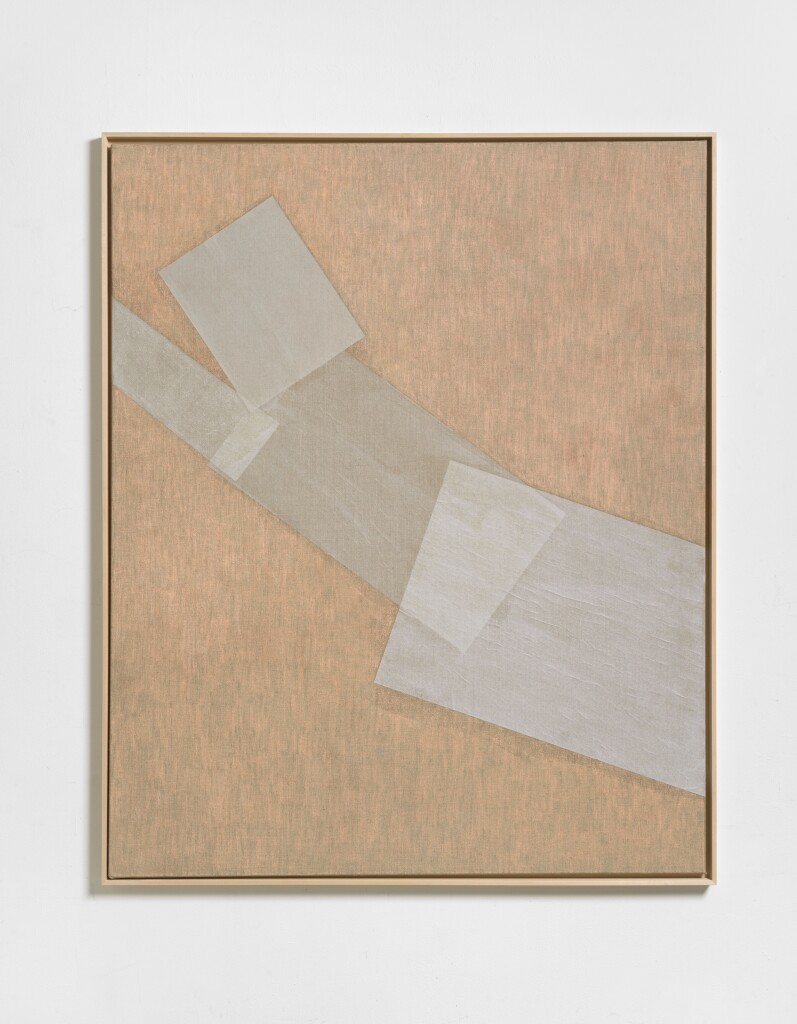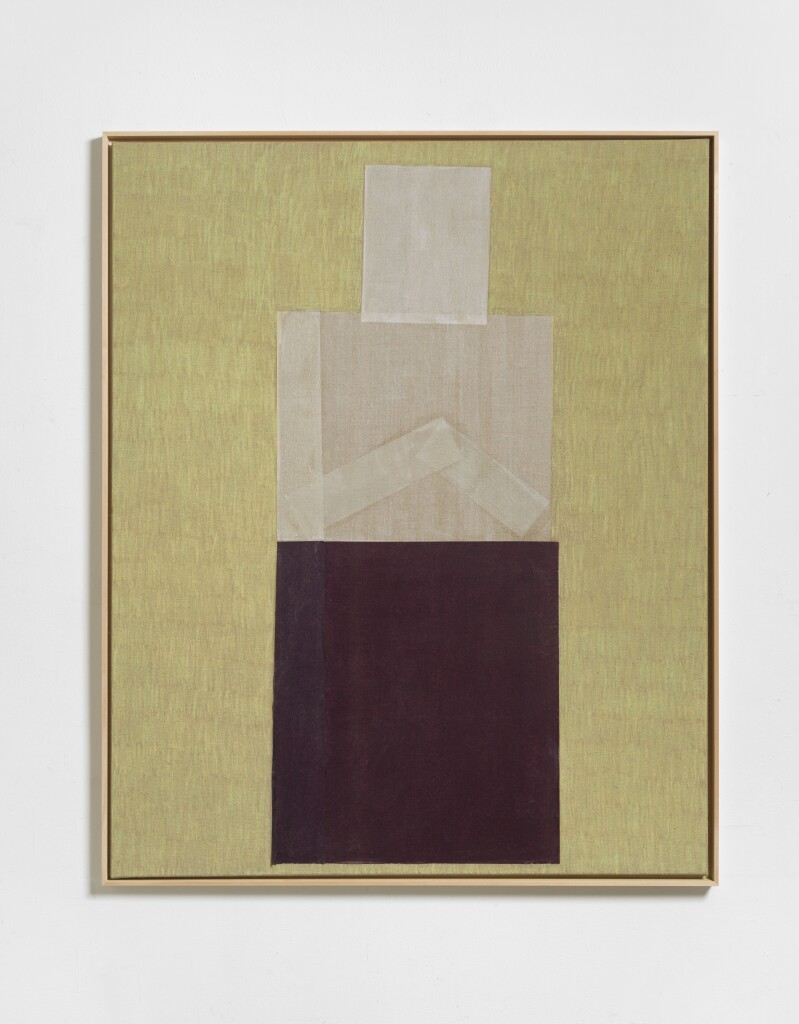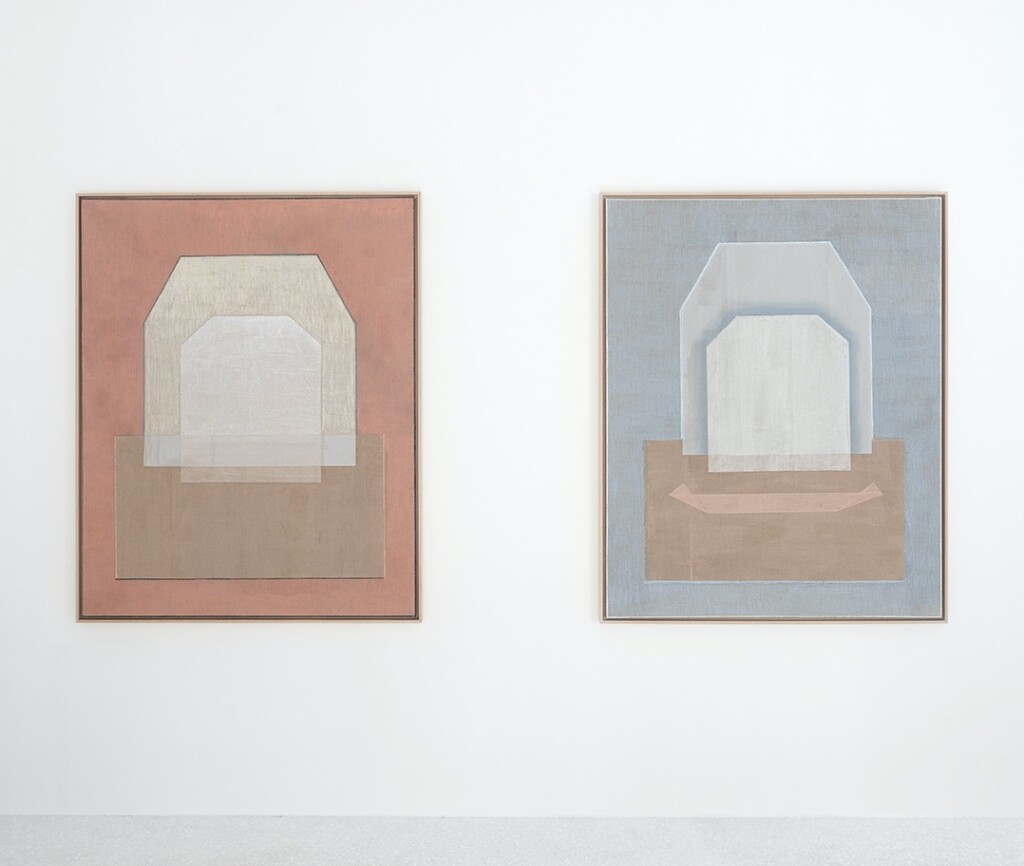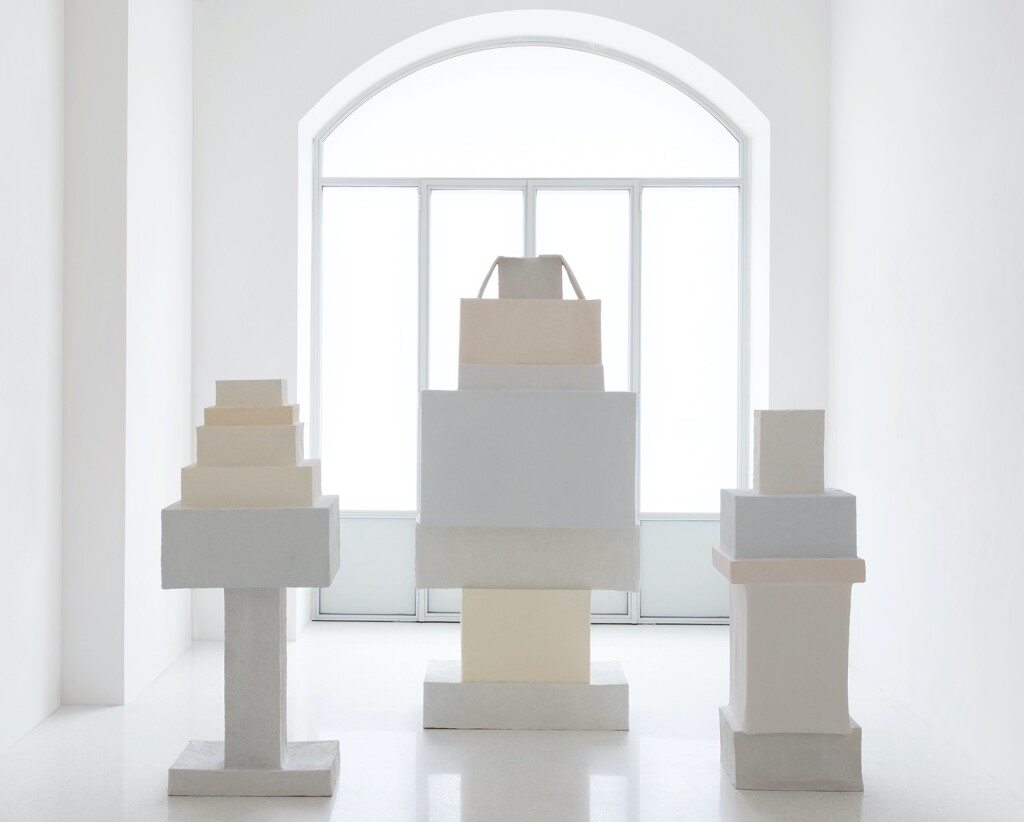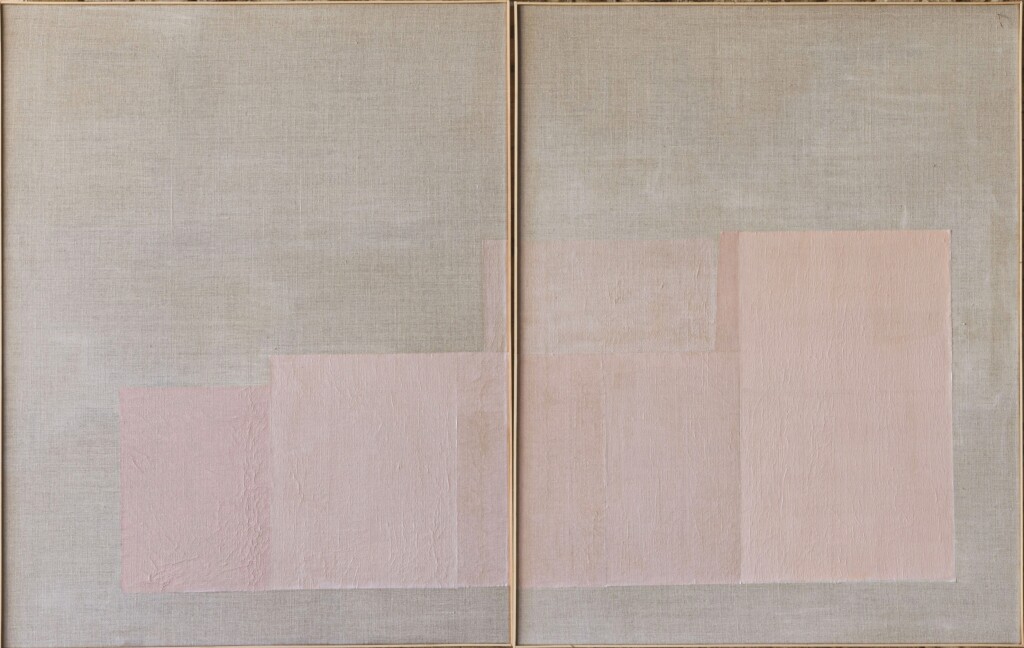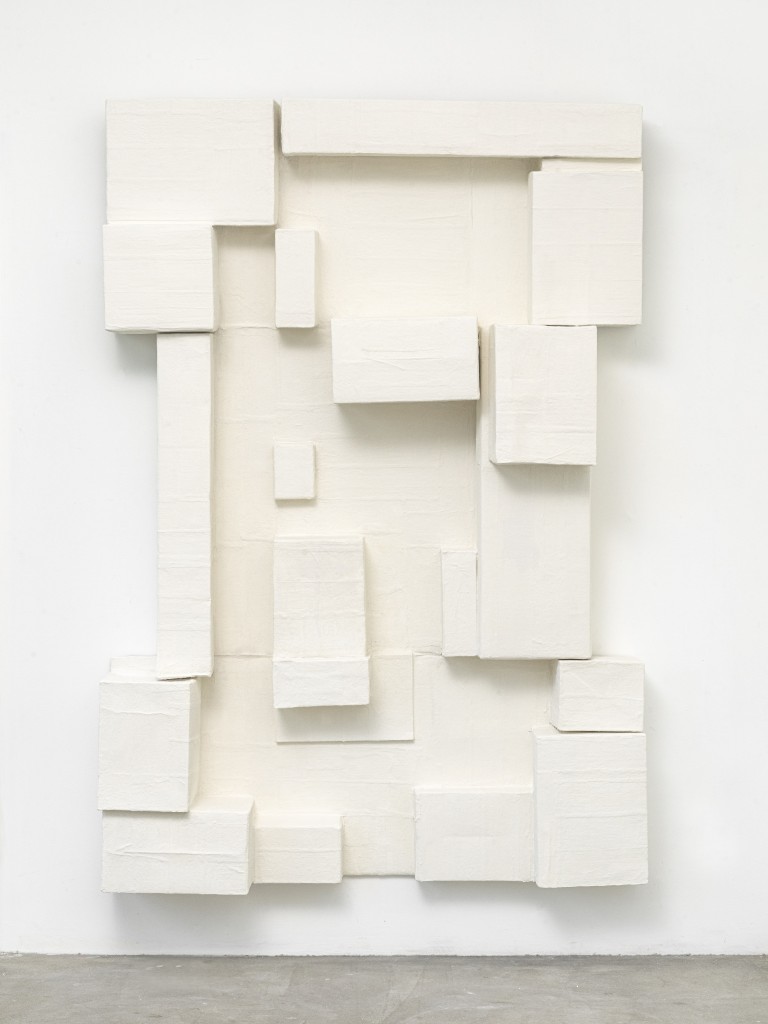Miart Milan April 11 – 14 _ ‘Zwischen Tür und Angel III’ 180 x 160 cm paper on linen 2024
At an earlier stage in Kim Bartelt’s career, she abandoned liquid paints to use planes of flat, often semi-transparent paper. Layering them to produce achingly minimal works that insist, gently but persistently, on the intrinsic relationship between colour, depth and space. Nowhere is this more apparent than in this recent series inspired by great works of the Renaissance. Works that both reduce and accentuate their original subject matter, injecting a kind of gestural romanticism through the language of squares and rectangles. Despite the compositional reduction of Bartelt’s Fra, 2022, the work loses none of the serene potency of Fra Angelico’s Saint Nicholas Altarpiece. In Please, 2022, Bartelt allows the gestural memory of the sculpture to inscribe an emotional value into her formally abstract work. Their geometric translation could so easily be distant and isolating, but with her lightness of touch, it triggers a deeper aesthetic response, preserving the sense of harmony that radiates from her work.
Extrait of the exhibition text for ‘Soft Guidance’ Cadogan Gallery London Jan 2024
by Duncan Ballantyne-Way
In Break Easy, the latest series of works by Kim Bartelt, a sequence of bevelled forms, hover in soft, pastel hues on smooth-coloured canvases. These seemingly rigid geometric structures are far from static but seem to tremble in their own symbolic abstraction. Partly made in response to a statement once posed by the poet, Ocean Vuong, that the most powerful and strengthening thing an artist can do, is to “bring down the shield (they’ve) been taught to put up around them”, the works in the series consider the role of the artist; and in doing so, create a visual language that resonates with intellectual introspection and discordant energy.
In her sculptural work, the rigid angular blocks may at first appear robust yet they are a hollow shell, made from stiff, everyday cardboard. At a time when the influence of robotics and advanced AI technology are starting to be felt in the contemporary world – with the capacity, according to many experts, to affect our society to a greater degree than electricity and fire – Bartelt’s sculptures are nothing but fragile beasts, enfeebled and defenceless. They look as though the slightest push could topple them over. Yet they stand guard across the exhibition, a potent reminder of firmly held convictions now in flux; of beliefs once thought unquestionable suddenly outdated.
These redundant massive forms focus attention on the surrounding wall works that line up side by side, their serene tones quivering in impressive silence. Their power stemming from their subtle interplay between depth and flatness and their gently antagonistic use of colour. Even with that delicate intensity the works in the series don’t pursue an emotional rawness but reach instead for something elemental and open. Without offering any form of resolution they instead engage a sensory dimension, articulating unknown sentiments that reveal the contradictory threads of the human condition and the emotional resilience required to be an artist.
extract of the exhibition text for ‘Break Easy’ at Cadogan Gallery Milan, May 2023
.
.
Rhythm is the timing of events on different scales, a movement marked by the regulated succession of strong and weak elements, of opposite or different conditions. Human rhythm recalls the cadence with which we walk and the regularity of the heartbeat, planetary-scale rhythms determine the changing of seasons, tidal movements, and the deep-time geological choreographies of carbon.
The rhythms that support and nourish us, like good translations, are more successful when we don’t need to think about them, when they are hardly visible to the bare eye. Explored in various degrees, the work of Kim Bartelt is an exploration of transparency and opacity, of that which is left unsaid and the understated. Like a proficient translator, she rejects artifice and embraces simplicity with a determined artistic gesture.
While evocative in her approach, Kim Bartelt foregrounds the material, making every step in her artistic process visible. In her sense of composition, she fuses geometrical outlines with textures that range from rough to extremely delicate in works that are gifted with balance and harmony. While looking at her paintings, they appear as an attempt at a cartography of networks, as silent mind maps of the support infrastructures that are always running in the backdrop of our existence.
These series mark a further step in Bartelt’s resignification of painting, pushing the medium’s openness to different ends. For Kim Bartelt’s work should remain an exercise of deep contemplation or, better said, a study of the poetics of the connective tissue of life.
Extract of a text by Lorena Juan, 2022
Lorena Juan is a curator and art mediator based in Berlin. Her most recent projects were shown at transmediale studio, Circle Culture Gallery, HKW, AdK, Silent Green, Schwules Museum Berlin, nGbK and Kunstraum Kreuzberg/ Bethanien.
.
Bartelt’s recent body of works turns the surface of the material support into a figure. Her paintings are arrangements of square and rectangular pieces of wrapping paper pasted on the frontal surface of the canvas. The artist uses them to construct each work, responding to the two-dimensionality of painting by covering the material support with two-dimensional building blocks. The pasted pieces of wrapping paper position Bartelt’s work as a reflection on the particular material givens of painting (with which it distinguishes itself from other artistic disciplines and media). Nevertheless, the work exceeds the confinements of formalism and amounts to an existentialist expression conveying the ephemerality and fragility of our current world. The wrapping paper is more than shape and texture. It is also an index of temporality, transition, and in-betweenness, lending the work a placeless quality. And the fact that the same wrapping paper is used in everyday circumstances for packing precious personal belongings and items situates the work as an extension of private life.
Bartelt’s work eventually achieves conceptuality through its investment in the physical properties of painting. Her arrangements of pieces of wrapping paper are also preparatory work, a delineation of areas to be painted. They are like a removable protection, intimating an ideal future painting. In this sense they are strictly conceptual—conveying in them an idea for a painting to come, realizing a concept of a painting not yet realized.
Extract of a text by Ory Dessau for ‘A Double Presentation’ together with Johannes Schön at Wilhelmhallen, Sept 2021
Ory Dessau (°1979, Tel Aviv) is an independent curator and writer based in Ghent. He has collaborated with museums such as the Tel Aviv Museum of Art, Neue Nationalgalerie, Berlin, S.M.A.K., Ghent, and Moderna Museet Malmö. Dessau’s texts are regularly published in art magazines such as Art Review, Flash Art, Mousse Magazine, and Metropolis Magazine.
Images – Roman März
